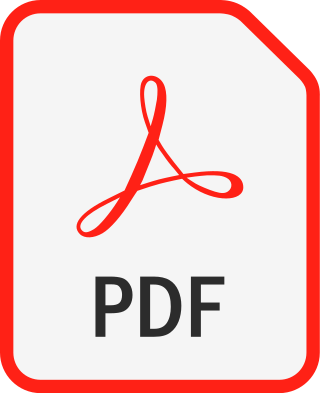A file viewer is a software application that represents the data stored in a computer file in a human-readable form. The file contents are formatted in a meaningful way, then displayed on the screen, printed out, or read aloud using speech synthesis.

Portable Document Format (PDF), standardized as ISO 32000, is a file format developed by Adobe in 1992 to present documents, including text formatting and images, in a manner independent of application software, hardware, and operating systems. Based on the PostScript language, each PDF file encapsulates a complete description of a fixed-layout flat document, including the text, fonts, vector graphics, raster images and other information needed to display it. PDF has its roots in "The Camelot Project" initiated by Adobe co-founder John Warnock in 1991.

Adobe Photoshop is a raster graphics editor developed and published by Adobe Inc. for Windows and macOS. It was originally created in 1987 by Thomas and John Knoll. Since then, the software has become the most used tool for professional digital art, especially in raster graphics editing. The software's name is often colloquially used as a verb although Adobe discourages such use.
The JPEG File Interchange Format (JFIF) is an image file format standard published as ITU-T Recommendation T.871 and ISO/IEC 10918-5. It defines supplementary specifications for the container format that contains the image data encoded with the JPEG algorithm. The base specifications for a JPEG container format are defined in Annex B of the JPEG standard, known as JPEG Interchange Format (JIF). JFIF builds over JIF to solve some of JIF's limitations, including unnecessary complexity, component sample registration, resolution, aspect ratio, and color space. Because JFIF is not the original JPG standard, one might expect another MIME type. However, it is still registered as "image/jpeg".

Adobe Illustrator is a vector graphics editor and design program developed and marketed by Adobe Inc. Originally designed for the Apple Macintosh, development of Adobe Illustrator began in 1985. Along with Creative Cloud, Illustrator CC was released. The latest version, Illustrator 2023, was released on October 18, 2022, and is the 27th generation in the product line. Adobe Illustrator was reviewed as the best vector graphics editing program in 2021 by PC Magazine.

Adobe InDesign is a desktop publishing and page layout designing software application produced by Adobe Inc. and first released in 1999. It can be used to create works such as posters, flyers, brochures, magazines, newspapers, presentations, books and ebooks. InDesign can also publish content suitable for tablet devices in conjunction with Adobe Digital Publishing Suite. Graphic designers and production artists are the principal users.
COLLADA is an interchange file format for interactive 3D applications. It is managed by the nonprofit technology consortium, the Khronos Group, and has been adopted by ISO as a publicly available specification, ISO/PAS 17506.
The Extensible Metadata Platform (XMP) is an ISO standard, originally created by Adobe Systems Inc., for the creation, processing and interchange of standardized and custom metadata for digital documents and data sets.
Open XML Paper Specification is an open specification for a page description language and a fixed-document format. Microsoft developed it as the XML Paper Specification (XPS). In June 2009, Ecma International adopted it as international standard ECMA-388.

Graphic art software is a subclass of application software used for graphic design, multimedia development, stylized image development, technical illustration, general image editing, or simply to access graphic files. Art software uses either raster or vector graphic reading and editing methods to create, edit, and view art.

Adobe Bridge is a free digital asset management app made by Adobe Inc. and first released with Adobe Creative Suite 2. It is a mandatory component of Adobe Creative Suite, Adobe eLearning Suite, Adobe Technical Communication Suite and Adobe Photoshop CS2 through CS6. Starting with Creative Cloud, however, it has become an optional component downloaded via Creative Cloud subscription.
PDF/A is an ISO-standardized version of the Portable Document Format (PDF) specialized for use in the archiving and long-term preservation of electronic documents. PDF/A differs from PDF by prohibiting features unsuitable for long-term archiving, such as font linking and encryption. The ISO requirements for PDF/A file viewers include color management guidelines, support for embedded fonts, and a user interface for reading embedded annotations.
Adobe Illustrator Artwork (AI) is a proprietary file format developed by Adobe Systems for representing single-page vector-based drawings in either the EPS or PDF formats. The .ai filename extension is used by Adobe Illustrator.
PRC is a file format that can be used to embed 3D data in a PDF file.
3DS is one of the file formats used by the Autodesk 3ds Max 3D modeling, animation and rendering software.
Universal Scene Description (USD) is a framework for interchange of 3D computer graphics data. The framework focuses on collaboration, non-destructive editing, and enabling multiple views and opinions about graphics data. USD is used in many industries including visual effects, architecture, design, robotics and CAD. It is developed by Pixar and was first published as open source software in 2016, under a modified Apache license. Pixar, Adobe, Apple, Autodesk, and NVIDIA, together with the Joint Development Foundation (JDF) of the Linux Foundation, announced the Alliance for OpenUSD (AOUSD) on August 1, 2023 to "promote the standardization, development, evolution, and growth of Pixar's Universal Scene Description technology."
